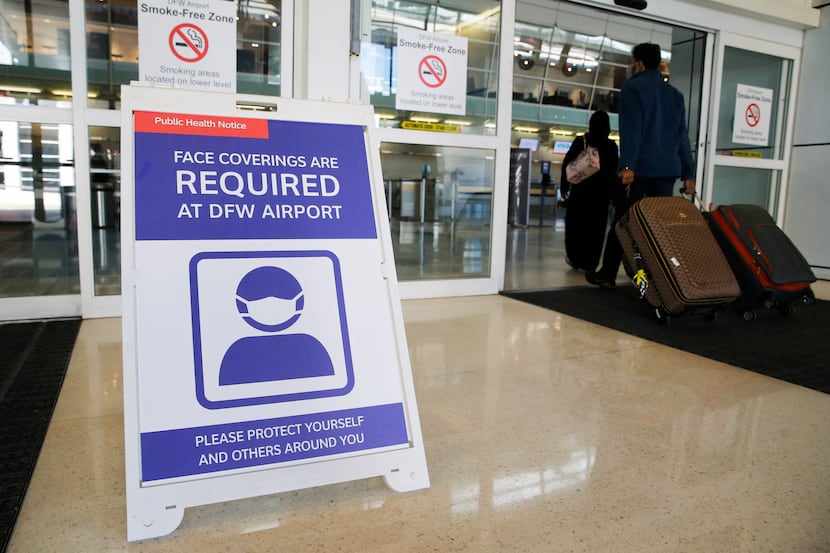Updated 2 p.m. Jan. 29: Revised to include updated information about the COVID-19 variants.
With new and possibly more contagious strains of the novel coronavirus beginning to circulate, the nation’s top infectious disease expert has said doubling up on face masks may offer people more protection against COVID-19.
The Centers for Disease Control and Prevention is monitoring three new strains of the virus, one that was first detected in the United Kingdom, known as B.1.1.7, one that was first detected in South Africa that is being referred to by the CDC as B.1.351, and one first detected in Brazil referred to as P.1.
The variant first identified in the U.K. has been confirmed in more than 300 people in nearly 30 states, according to the CDC. As of Jan. 28, four cases had been confirmed in Dallas County. Health experts say it could quickly become the dominant source of new COVID-19 infections.
Two cases of the variant that was first identified in South Africa and one case of the variant first identified in Brazil have been confirmed in the United States.
Although more information is needed to know the new strains’ exact effects on the people they infect, health experts say that varieties that spread more easily raise new concerns because additional COVID-19 cases could overwhelm already burdened health care systems.
Here’s what you need to know about when and how to double up on face masks.
When should you wear more than one mask?
Dr. Anthony Fauci, adviser to President Joe Biden, told the Today show this week that “it just makes common sense” that double-masking would provide more protection against COVID-19.
But health experts say not every situation requires the extra layer.
Monica Gandhi, a professor of medicine and an infectious disease expert at the University of California at San Francisco who co-wrote a recent commentary on wearing masks, told The Washington Post that people should consider adding a layer when they are spending time where they are more likely to be exposed to the virus — indoors and around crowds.
Health experts say people should also consider doubling up if their masks are thin or don’t fit well, or if they are at a high risk of becoming seriously ill if they get infected.
“The more layers you have covering your nose and mouth means less virus you’re able to disseminate into the population,” Thomas Duszynski, director of epidemiology education at Indiana University’s Richard M. Fairbanks School of Public Health, told HuffPost. “And then the more layers you have between you and the environment, the fewer viral particles are going to get into your system.”
How do you layer masks?
The most effective type of face masks are N95s, health experts. If you have an N95, health experts say you don’t need to layer it. Those masks are still in limited supply, but you can mimic the benefits of an N95 by layering different types of masks.
The main benefit of increasing the layers is to improve air filtration and the fit of the face covering, health experts say. To be most effective, a mask with good filtering capabilities should go underneath another layer.
Last year, the Food and Drug Administration gave emergency use authorizations to several types of the Chinese version of the N95, known as a KN95. Although they aren’t as effective as N95s, they are a good alternative, health experts say.
In the commentary co-authored by Gandhi, researchers say one option is to use a KN95 mask and place a cloth mask over it. People also may use a surgical mask as the bottom layer.
Aside from providing an extra level of filtration, doubling up also closes gaps around the face, which can be left with looser surgical masks.
If people don’t have a KN95 or a surgical mask, people can wear cloth masks that have pockets to add a filter. Some manufacturers sell masks with replaceable filters, but if a cloth mask doesn’t come with one, a vacuum bag filter or a coffee filter can help catch small particles, the researchers write in the commentary.
The multiple layers will create an “obstacle course” that makes it harder for people to breathe in infectious particles, health experts say.
“The air has to follow this tortuous path,” Linsey Marr, an expert in virus transmission at Virginia Tech who wrote the commentary with Gandhi, told The New York Times. “The big things it’s carrying are not going to be able to follow those twists and turns.”
It’s important to be strategic about layering masks, health experts say. Doubling up on any material, or creating too many layers, may make it more unpleasant to breathe.
“If you put three or four masks on, it’s going to filter better because it’s more layers of cloth,” Dr. Scott Segal, chairman of anesthesiology at Wake Forest Baptist Health in Winston-Salem, N.C., told NBC News. “But you’ll be taking it off because it’s uncomfortable.”
It’s also important to remember that double-masking is not a substitute for other public health measures. The same guidelines about preventing infection still apply: Stay home whenever possible, avoid crowds and stay at least 6 feet apart from others in public spaces.

